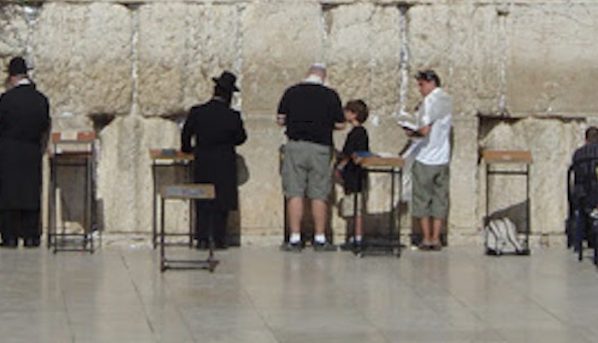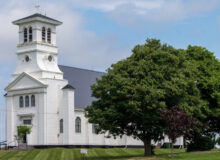Thursday evening, May 18th, until the beginning of Shabbos on Friday, May 18, is the holiday of Yom Yerushalayim (Jerusalem Day) The anniversary of the day during the Six Day War in 1967 when the IDF re-took Jerusalem.
On that day in 1967, for the first time since 70 CE, Jerusalem, the eternal capital, was united and under the control of the Jewish people. Jews were once again permitted to go to Mount Moriah. The top of Mount Moriah, known as the Temple Mount, is the holiest site in the Jewish faith.
What is left of the retaining wall around the temple mount is called the Kotel (wall). Some call it the Wailing Wall or Western Wall.
Today the Muslims claim the Temple Mount is theirs, and there was never a Jewish temple on top of Mount Moriah. Even the United Nations denies the Temple Mount’s Jewish heritage. But any claim that the Temple Mount is anything but Jewish it’s all propaganda that ignores that the ancient Greeks, Romans, Christians, and even the ancient Muslims wrote that Jerusalem and the Temple Mount were the property of the Jewish people.
I am not going to argue historical facts here today. I am not here to argue history or tradition, nor will I make jokes about the fact that when Muslims in Israel face Mecca to pray, they are mooning the Temple Mount (but it’s simple geography).
The reason I don’t have to argue about Mount Moriah is that I’ve been to the Kotel, which is at the bottom of the Temple Mount. And as corny as it may sound to anyone who has never been there, I felt the presence of God at the Temple Mount.
I didn’t get to go to the holiest place in the Jewish faith, the top of Mount Moriah (only Muslims are allowed to pray there–long story), I did get to pray at the Kotel.
All my life, I had this overwhelming desire to go to Jerusalem and especially the Temple Mount. I never understand why I had that urge until I stood in its presence during my first trip to Israel.
Before we went to Jerusalem, our guide, Yossi, took us north to Haifa on our second day to Tzvat. Yes, day Tw0 b’Tzvat (sorry, I can’t help myself from that pun). After that, we traveled to Israel’s borders with Lebanon, Jordan, and Syria.
After a few days, we finally approached Jerusalem from the north. I still remember that as soon as we drove through the hills, I got to peek at Jerusalem from far away. Strangely at that moment, for the first time in my life, I felt comfortable in my surroundings.
Jerusalem felt like home to me, despite the fact that I had never been there. Amazingly I knew where to go and how to get around this holy city without looking at a map.
There were times that I would tell my family that I knew a shortcut to get to where we needed to go, and my wife, who had been there before, would tell me I was crazy (which is entirely true but has nothing to do with our visit to the eternal capital) My directions/shortcuts were always correct–perhaps because I had read so much about the city, or maybe it was something else.
Everywhere we went in Jerusalem, I knew where we were and its relation to the Temple Mount. And the closer we got to Mount Moriah, the lure of the Temple site was stronger.
Now at this point, anyone reading this who has never been to Israel is probably calling for the guys in white coats to bring me one of those lovely jackets–you know, the ones with very long sleeves that tie in the back so they could drag me away peacefully.
But before you make that call, ask anyone who has been there (anyone who believes in God) and ask if their feelings were any different than mine. Trust me, their feelings will be the same.
On our second day in Jerusalem, we were finally going to the Kotel. With rare exceptions, it’s the closest any Jew can get to the top of the Temple Mount. On top of Mount Moriah, where each Beit Hamikdash (Temple) stood, the holiest place in the world for the Jewish people, no praying is allowed for non-Muslims. That law was created by the Israeli Government to keep the peace with Muslims.
The whole family got up early that day. I packed up my Tallit (prayer shawl), Siddur (prayer book), and Tefillin (small black leather boxes containing scrolls of parchment inscribed with verses from the Torah attached to straps and worn by adult Jews during morning prayers. We took off with Yossi, our fantastic guide. He built up my anticipation by taking us all over the Old City.
Yossi knew how important going to the Kotel was to me. Yet instead of going directly to it, he teased me with, “It’s right over that wall; we will see this movie first, or let’s go to the burnt house, etc.” I was getting very frustrated, but he was masterfully building up my expectations. Finally, we walked down the wooden stairway and walked through the gate of the Kotel Plaza.
I was overwhelmed by emotions that I had never felt before.
All my life, I felt a longing to go to the Kotel, and I finally knew why. You see, everywhere else you go in Israel, you can sense the presence of all that had gone on before you, King David, Abraham, the 12 tribes, the two kingdoms, and on and on. It’s about culture and history.
But when you visit Jerusalem, especially as you get close to Mount Moriah, it is all about God. It is about being able to feel the lingering remnant of the Shechinah (God’s presence) that left just before the first Beit Hamikdash was destroyed over 2,500 years ago, never to return.
At the Kotel, I learned that the dispute over the Temple Mount isn’t political. It is all about de-legitimizing the Jewish presence in Jerusalem and trying to disconnect the Jews relationship with their maker. No one had to teach that I was there. I felt it.
With my son, then ten years old, holding my bag, I celebrated my lifelong dream. I wrapped one of the Tefillin around my arm, placed the other on my head, wrapped my Tallit around my son and me, and prayed to our maker. I started = with the Shehechayanu prayer to thank the Lord for allowing us to get to the Kotel. The English translation of the prayer is “Blessed are You, Lord our God, King of the Universe, who has granted us life, sustained us and enabled us to reach this occasion.” That prayer never meant as much to me as when I recited it at the Kotel with tears in my eyes.
I continued with the prayers I had recited hundreds of times before, but this time, it was different. It felt so much more than just praying at the Kotel. Those words of Hebrew seemed to have meaning like never before. I was connecting–connecting with the God of Avraham, Yitzchak, and Yaakov.
That’s when I realized that “urge” I had felt all my life–wasn’t an urge, it was an invitation from my maker, “Come visit so we can talk, it’s a local call.” And while I know that God is everywhere, for some reason only a Rabbi can explain, his presence is much stronger in Jerusalem and even stronger near the Temple Mount.
THERE! That’s it; that’s my proof; that’s how I know that the Temple Mount is Jewish. Nothing scientific, nothing that will work in a court of law or an international dispute. it’s all about faith. I felt this incredibly strong connection to the Lord at the Kotel. There is no other place in the entire world where one can get that feeling. Where did that connection originate? Maybe it’s something in the DNA of a Jew that acts as a homing device. Just as a compass always points to the north, the heart of a Jew always points to the Temple Mount in Jerusalem.
As it is said, Israel is the heart of the Jewish people, Jerusalem is the heart of Israel, and Mount Moriah is the heart of Jerusalem.
Jeff is the Director of Special Projects for Herut North America and Editor/Publisher of The Lid.
k






